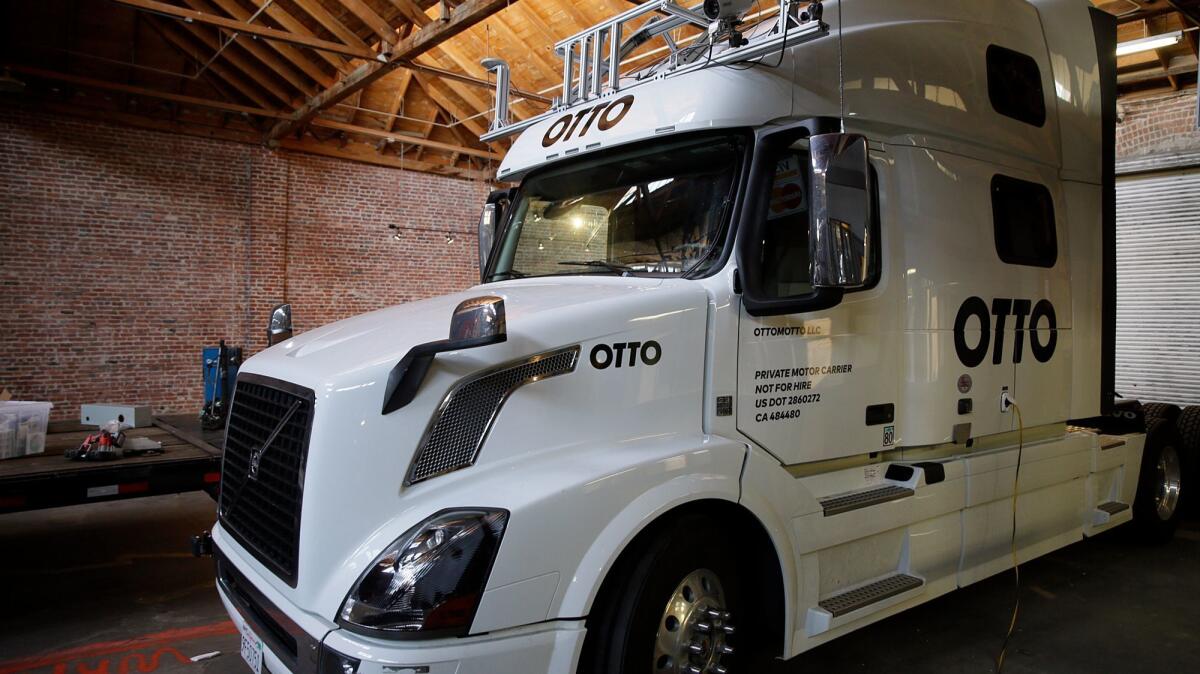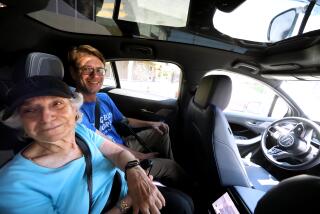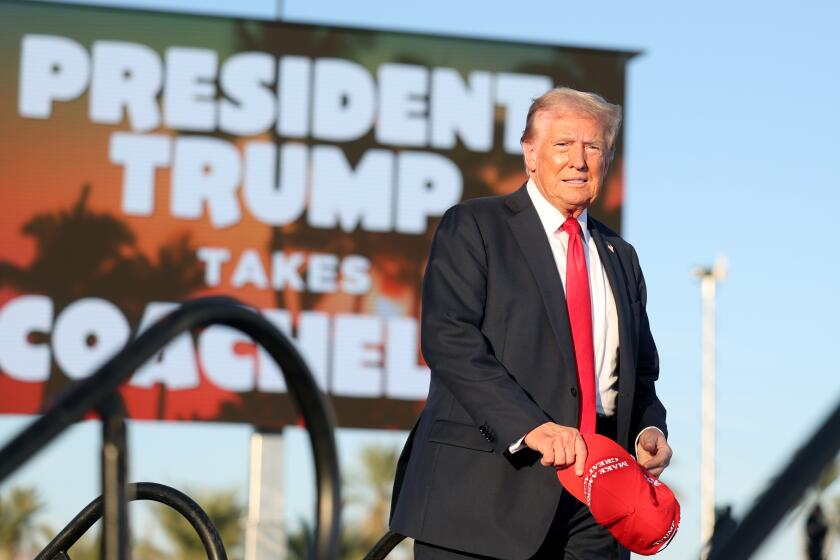The driverless revolution may exact a political price

Reporting from Washington — In its race to embrace driverless vehicles, Washington has cleared away regulatory hurdles for auto companies and brushed aside consumer warnings about the risk of crashes and hacking.
But at a recent hearing, lawmakers absorbed an economic argument that illustrated how the driverless revolution they are encouraging could backfire politically, particularly in Trump country.
It was the tale of a successful, long-distance beer run.
A robotic truck coasted driverless 120 miles down Interstate 25 in Colorado on its way to deliver 51,744 cans of Budweiser. Not everyone at the hearing was impressed by the milestone, particularly the secretary-treasurer of the Teamsters, whose nearly 600,000 unionized drivers played no small role in President Trump’s victory last year.
Driverless vehicles threaten to dramatically reduce America’s 1.7-million trucking jobs. It is the front end of a wave of automation that technologists and economists have been warning for years will come crashing down on America’s political order. Some predict it could rival the impact of the economic globalization and the resulting off-shoring of jobs that propelled Trump’s victory in the presidential election.
“This is one of the biggest policy changes of our generation,” said Sam Loesche, head of government affairs for the Teamsters. “This is not just about looking after the health and welfare of America’s workers, but also their livelihoods.”
Washington isn’t ready for it. The Trump White House already has indicated it sees it as some future administration’s problem. Silicon Valley remains in shock over Treasury Secretary Steven T. Mnuchin’s remark in the spring that economic fallout from this type of automation is 50 to 100 years off and “not even on my radar screen.”
“I don’t think anybody there is thinking about this seriously,” said Martin Ford, author of “Rise of the Robots: Technology and the Threat of a Jobless Future.” “They are still looking at this as futuristic and not having an impact and not politically toxic. … Once people start seeing the vehicles on the roads and jobs disappearing because of them, things will quickly become very different.”
The arrival of that reckoning is getting accelerated by Washington’s bipartisan excitement for self-driving technology, one of the few policy issues advancing. New Trump administration regulations don’t require industry to submit certain safety assessments, leaving it voluntary. And legislation — already approved in the House and expected to pass in the Senate — strips authority from states to set many of their own safety guidelines.
Objections raised by the National Governor’s Assn. and the National Council of State Legislatures don’t seem to be slowing things down. Consumer groups are dismayed.
“We understand how beneficial this technology can be, but we also understand that if we screw this up, human lives will be lost,” said Jackie Gillan, head of Advocates for Highway and Auto Safety. “We are at a time when there are already record recalls of vehicles because of safety defects. Why are we trusting these companies to do the right thing?”
Lobbying from the Teamsters succeeded in stripping commercial vehicles from the rapidly advancing congressional action. Automated commercial trucks would not get the exemptions to state and many federal rules as robot cars would in the legislation.
The concession — heralded as a big victory by the Teamsters — was met with a shrug by many in the automation world. They don’t expect it to slow the arrival of fleets of self-driving trucks on the road. The momentum is already there, they say, and agency regulators are working with the companies to get their prototypes highway-ready.
“It was a political sign that there is fear” about the impact of the trucks, said Bryant Walker Smith, a law professor at the University of South Carolina who researches vehicle automation. “But it is not in the long term going to hamper their deployment.”
How soon the potential for economic disruption spills over into politics is a matter of debate among technologists and futurists. But they agree it will be much sooner than Mnuchin predicts, and possibly as soon as 2020, when Trump would be up for reelection.
Trump claimed a bigger share of the labor vote than any Republican since Ronald Reagan, winning 43% of it nationwide, exit polls show. In Ohio, he beat Hillary Clinton commandingly in union households.
Hanging onto those votes is not as simple as tapping the brakes on driverless technology. Such a move would have its own economic fallout, as companies developing the vehicles could merely move abroad.
But if the White House and Congress don’t start addressing the disruption that self-driving vehicles and related automation will cause, economists and political scientists warn Washington may one day face the kind of voter backlash seen in the 2016 election. So far, the government is showing itself just as disconnected as it was to the troubles created for the same voters by globalization.
“Regardless of whether this creates a world where everyone has jobs or few people do, those jobs will be different,” Smith said. “Congress is not effectively discussing this. We don’t sufficiently understand this disruption.”
At a California start-up called Embark, there already are indications of how trucking jobs are about to change. The company has in recent weeks started test-runs in which it is using self-driving trucks to ship smart refrigerators from a warehouse in Texas to a distribution center in Palm Springs. There is a driver in the cab, but for the bulk of the ride, when the truck is on the 10 Freeway, that person is not doing the driving. Eventually, there could be nobody in the cab for legs of the trip.
Embark’s head of public policy, Jonny Morris, joins the American Trucking Assn. in offering an optimistic vision — one in which truck drivers still will have jobs and their quality of life will be much improved. Instead of making long hauls thousands of miles, Morris said, they could stay in their communities and handle the more-complicated short hops at the beginning and end of the trips, along with loading and unloading. “We believe automation can help improve the number and quality of jobs,” he said.
Teamsters executives are skeptical, particularly as many pilot programs exhibit a diminished role for blue-collar workers. Volvo, for example, boasts how the autonomous garbage truck it developed doesn’t need a driver in the cab to navigate the route, freeing up that person to load the trash bins. Two jobs appear to become one.
Many of the new positions created by such technology look nothing like the stable trucking jobs that are a staple of blue-collar America. They involve coding, data analysis and operation of complicated computer systems. The training is sophisticated and costly. A college degree could become a prerequisite.
Ford says the White House and Congress better start paying closer attention to what self-driving technology means for truckers and others displaced by the new industry.
“If we don’t figure out a way to solve this,” he said, “there is going to be a backlash.”
Follow me: @evanhalper
ALSO
Volvo to supply Uber with up to 24,000 self-driving SUVs for taxi fleet
Tesla unveils electric truck with 500-mile range — and teases a new sports car
Tesla’s entry into truck-making presents a whole new challenge for Elon Musk
More to Read
Get the L.A. Times Politics newsletter
Deeply reported insights into legislation, politics and policy from Sacramento, Washington and beyond. In your inbox three times per week.
You may occasionally receive promotional content from the Los Angeles Times.











